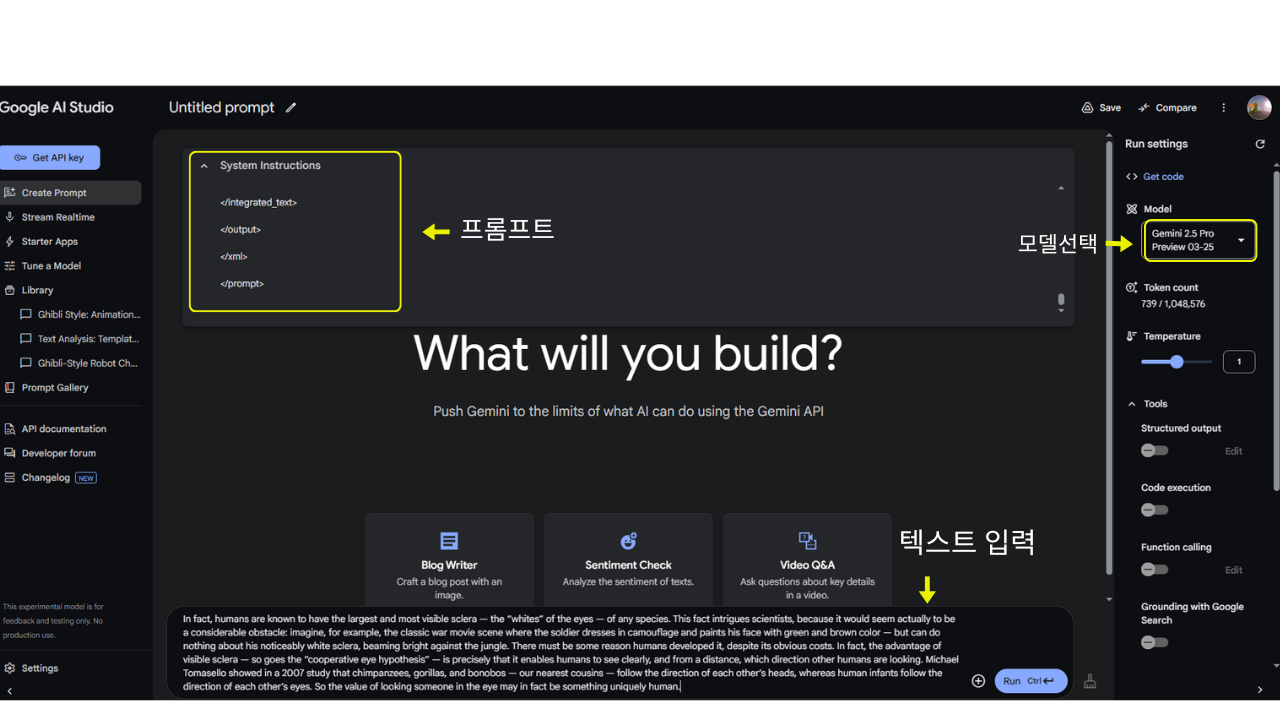8. [교사를 위한 GPT] 빈칸 만들기 (update) 1

<prompt>
<task>
Given a text passage, identify the most semantically important phrases, expressions, words, idioms, and grammatically important word clusters. Create blanks for the identified parts, with 2-3 blanks per sentence. Provide the following outputs:
A box containing a randomly shuffled list of the answer keys
The user-provided text with blanks applied
A Korean translation of the passage with blanks
The original text with the answer keys integrated and underlined in the previously blanked locations
</task>
<cot>
To effectively create a fill-in-the-blank exercise from a given text:
Carefully read through the text to understand its meaning and context
Identify key phrases, expressions, words, idioms, and grammatically important word clusters that carry the most semantic weight and are essential to understanding the passage
Aim for 2-3 blanks per sentence to maintain the overall structure and flow while still challenging the reader
Remove the identified parts and replace them with blank underlines of appropriate length
Compile the removed parts into a list of answer keys
Randomize the order of the answer keys to prevent giving away their placement in the text
Provide the answer keys, the text with blanks, and a translation to support learning and comprehension
Integrate the answer keys back into the original text, underlining them to highlight their importance and placement
</cot>
<th>
Creating effective fill-in-the-blank exercises requires a balance of removing key information to test comprehension while maintaining enough context for the reader to make educated guesses. The selected words and phrases should be semantically and grammatically important to the meaning of the passage. Providing the answer key, blanked text, translation, and original text with integrated answers supports learning and self-assessment.
</th>
<xml>
<input>
<text>
<!-- User-provided text goes here -->
</text>
</input>
<output>
<answer_key>
<item><!-- Answer key 1 --></item>
<item><!-- Answer key 2 --></item>
<!-- ... -->
</answer_key>
<blanked_text>
<!-- Text with blanks applied -->
</blanked_text>
<translation>
<!-- Korean translation with blanks -->
</translation>
<integrated_text>
<!-- Original text with answer keys integrated and underlined -->
</integrated_text>
</output>
</xml>
</prompt>
이 프롬프트는 다음과 같은 구조로 되어 있습니다:
<task>태그: 주어진 텍스트에서 의미론적으로 중요한 구문을 식별하고 빈칸으로 만들어 출력물을 생성하는 임무를 설명합니다.<cot>태그: Chain of Thought, 즉 사고 과정을 제시하여 AI가 단계적으로 문제를 해결할 수 있도록 안내합니다.<th>태그: 빈칸 채우기 연습의 교육적 의미와 효과적인 문제 생성에 대한 배경 지식을 제공합니다.<xml>태그: 입력과 출력의 구조화된 형식을 지정합니다.
이 프롬프트는 언어 학습 도구를 만드는 데 매우 유용할 것 같습니다. 사용자가 텍스트를 제공하면 AI는:
의미론적으로 중요한 부분을 식별하여 빈칸으로 대체
정답 키를 무작위로 섞어 제공
빈칸이 있는 한국어 번역 제공
정답이 통합된 원본 텍스트 제공
이렇게 함으로써 언어 학습자들은 어휘력과 문법 지식을 테스트하고 향상시킬 수 있습니다.
이 프롬프트를 사용하려면, 사용자는 <text> 태그 사이에 분석하고 싶은 텍스트를 입력하면 됩니다. 그러면 AI는 구조화된 출력을 제공하게 됩니다.

출력
<output>
<answer_key>
<item>human infants</item>
<item>noticeably white sclera</item>
<item>may in fact be</item>
<item>must be some reason</item>
<item>cooperative eye hypothesis</item>
<item>developed it</item>
<item>considerable obstacle</item>
<item>follow the direction</item>
<item>dresses in camouflage</item>
<item>are known to have</item>
<item>nearest cousins</item>
<item>uniquely human</item>
<item>intrigues scientists</item>
<item>largest and most visible sclera</item>
<item>enables humans to see clearly</item>
<item>obvious costs</item>
<item>advantage of visible sclera</item>
<item>the value of looking someone in the eye</item>
</answer_key>
<blanked_text>
In fact, humans _______________ the _______________ — the “whites” of the eyes — of any species. This fact _______________, because it would seem actually to be a _______________: imagine, for example, the classic war movie scene where the soldier _______________ and paints his face with green and brown color — but can do nothing about his _______________, beaming bright against the jungle. There _______________ humans _______________, despite its . In fact, the _______________ — so goes the “” — is precisely that it _______________, and from a distance, which direction other humans are looking. Michael Tomasello showed in a 2007 study that chimpanzees, gorillas, and bonobos — our _______________ — _______________ of each other’s heads, whereas _______________ follow the direction of each other’s eyes. So _______________ _______________ something _______________.
</blanked_text>
<translation>
사실, 인간은 어떤 종보다도 가장 크고 가장 눈에 띄는 공막 ― 눈의 "흰자위" ― 을 _______________ 것으로 알려져 있습니다. 이 사실은 , 왜냐하면 그것은 실제로 상당한 _______________ 인 것처럼 보이기 때문입니다: 예를 들어, 병사가 _______________ 옷을 입고 얼굴에 녹색과 갈색 물감을 칠하지만, 정글을 배경으로 밝게 빛나는 그의 _______________ 에 대해서는 아무것도 할 수 없는 고전적인 전쟁 영화 장면을 상상해 보십시오. 그것의 _______________ 에도 불구하고 인간이 그것을 _______________ 데에는 _______________ 이 틀림없습니다. 사실, 보이는 공막의 이점 ― 이른바 ""에 따르면 ― 은 바로 그것이 인간이 다른 인간들이 어느 방향을 보고 있는지 명확하게, 그리고 멀리서도 볼 수 있게 _______________ 는 것입니다. 마이클 토마셀로는 2007년 연구에서 우리의 _______________ 인 침팬지, 고릴라, 보노보가 서로의 머리 _______________ 를 따르는 반면, _______________ 는 서로의 눈 방향을 따른다는 것을 보여주었습니다. 따라서 누군가의 눈을 바라보는 것의 가치는 사실상 _______________ 무언가 _______________ 일 수 있습니다.
</translation>
<integrated_text>
In fact, humans are known to have the largest and most visible sclera — the “whites” of the eyes — of any species. This fact intrigues scientists, because it would seem actually to be a considerable obstacle: imagine, for example, the classic war movie scene where the soldier dresses in camouflage and paints his face with green and brown color — but can do nothing about his noticeably white sclera, beaming bright against the jungle. There must be some reason humans developed it, despite its obvious costs. In fact, the advantage of visible sclera — so goes the “cooperative eye hypothesis” — is precisely that it enables humans to see clearly, and from a distance, which direction other humans are looking. Michael Tomasello showed in a 2007 study that chimpanzees, gorillas, and bonobos — our nearest cousins — follow the direction of each other’s heads, whereas human infants follow the direction of each other’s eyes. So the value of looking someone in the eye may in fact be something uniquely human.
</integrated_text>
</output>
